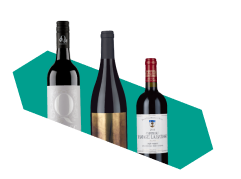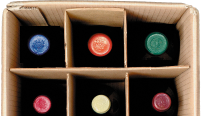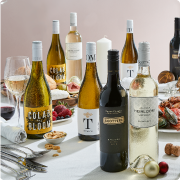You can’t beat a delicious glass of red – there’s a bottle to suit every occasion, from date nights to laid-back barbecues and festive celebrations. Red wines are diverse in style, ranging from deep and rich to lively and fruit-forward. They’re made worldwide, from Argentina to Australia, South Africa to France, and beyond. Some countries are particularly famous for their unique styles – think Italy’s Chianti and South Australia’s punchy Shiraz.
Our guide to the ten most popular types of red wine will help you find your new favourite – or discover something completely new to try.
What are the different styles of red wine?
Red wines are made in a range of styles, from light to full-bodied, and can range from lusciously sweet to bone-dry. Thanks to their unique characteristics, all types of red wines differ depending on the grape variety (or blend) used and the terroir in which they are produced.
Four core factors can affect a red wine’s style:
Body – Some full-bodied wines, such as Malbec and Shiraz, may feel heavier or thicker on the tongue, almost like cream-like consistency. Light-bodied reds, including Pinot Noir and Gamay, can feel more like skimmed milk when sipped.
Tannins – Tannins are a naturally occurring compound found in grape skins and seeds that add colour and improve the wine’s longevity (additionally, when wine is aged in oak barrels, tannins from the wood leach into the wine). Tannins are also the reason your tongue may feel dry or grainy after a sip. Full-bodied wines typically have more tannins than light-bodied wines. In ‘real wine’ terms, Nebbiolo is known for its tannic style, while Grenache has very few tannins (due to its thinner skin).
Sweetness – Wine grapes contain natural sugars converted to alcohol during fermentation. Wines with little to no sugar left after fermentation, such as Cabernet Sauvignon, are known as ‘dry’ wines. Fortified wines, such as Port, have high levels of residual sugar and taste sweet.
Effervescence – While still red wines are the most common and popular among red wine lovers, there are a few sparkling red options available including premium Australian Sparkling Shiraz. One of the most famous is Lambrusco, a fizzy red from Italy known for its juicy red fruit flavours.

Red wine blends
The wonderful world of different types of red wine goes beyond enjoying single varieties. Expert winemakers often combine two or more wine varieties to create complex and delicious red blends. Some of these blends have become famous worldwide, including Bordeaux and GSM blends.
What makes these blends so successful? They are perfectly balanced to highlight the characteristics of each grape variety used. Bordeaux red blends are some of the most popular, made from an expert combination of Merlot, Cabernet Sauvignon and Cabernet Franc. The wines are well-structured, deep and rich – look for dark fruit notes complemented by hints of herbs and tobacco. These blends are also known for their impressive ageing potential.
GSM blends are some of the most imitated and popular in the red wine world. They are made everywhere, from France’s Rhône Valley to Barossa Valley in South Australia. This blend includes Grenache, Shiraz and Mourvèdre and is known for its perfect balance of fruitiness, structure and spiciness.
Another popular red blend from the Rhône Valley is Châteauneuf-du-Pape. Also made using Grenache, these blends are full-bodied and rich, brimming with red and black fruit notes and earthy hints. This blend can contain up to 13 different grape varieties.
But France isn’t the only noteworthy home to red blends – Spain and Italy also have hugely popular blends. Spain’s Rioja wines are frequently produced as blends using the Tempranillo grape, known for its soft texture and bright red fruit notes.
Italy is home to Chianti – a medium-bodied blend with fresh acidity and juicy notes of cherry and plum – and Super Tuscan wines, both made from Sangiovese grapes in the western region of Tuscany.
Here in Australia, regions such as Margaret River, Yarra Valley and Coonawarra are famous for their Cabernet Sauvignon blends while Barossa Valley is home to some of the best old-vine Grenache blends in the world.

10 best types of red wine
Shiraz
Also known as Syrah, Shiraz’s style can vary depending on where the grapes are grown. However, this red is almost always bold and full-bodied. Australian Shiraz is known for its weighty black fruit, cracked black pepper and chocolate flavours, while French Syrah has more pronounced savoury notes and restrained fruit intensity.
With its robust structure, medium-high acidity and bold flavours, Shiraz pairs well with chargrilled steaks, tender beef cheeks with garlic roasted potatoes and spiced lentil dishes. Looking for a Shiraz to try? Patronus Barossa Valley Shiraz 2023 is a big, bold and lavish wine from South Australia’s famous Barossa Valley.
Pinot Noir
Pinot Noir is a light- to medium-bodied red with an easy-drinking acidity and silky texture. Bursting with a variety of red fruit and spice notes, with occasional earthy undertones, Pinot Noir is a lighter alternative to heavy reds. Originally from France’s prestigious Burgundy region, the Pinot Noir grape (one of the oldest varieties in the world) is grown across the winemaking world, from the US to Germany. Australia has some of the oldest Pinot Noir vines (if not the oldest) in the world.
Pinot Noir pairs wonderfully with a variety of dishes, from roast duck and grilled salmon to soft cheeses such as Brie and mushroom-based recipes. Pick up Ponting Mowbray Boy Tasmania Pinot Noir 2022, an elegant Pinot Noir with ripe cherry flavours balanced by cool-climate acidity, which is delicious with wild mushrooms and creamy chicken.
Merlot
Ranging from medium to full-bodied, this red is known for its smooth, plush texture and accessible style. Typically, Merlot has a medium acidity and moderate tannins. Highly regarded as an approachable red, Merlot is made in regions across France, Italy, Chile, the US and Australia.
The wine has prominent notes of juicy plum, black cherry and herbs. Sweeter aromas of chocolate and vanilla develop in oak-aged Merlot. Thanks to the soft tannins and fruity flavours in a smooth Merlot, the wine pairs very well with roast chicken and mildly spiced charcuterie. Caravan Merlot 2023 is a delicious Merlot made for easy drinking, perfectly balanced and brimming with fruitiness.
Cabernet Sauvignon
This bold, full-bodied red is one of the most popular red wines in the world and is available in a range of styles. In cooler climates such as Bordeaux and Argentina, Cabernet Sauvignon wines offer depth and structure, while those from warmer regions like South Australia and Chile present a riper, more complex style. Typical flavours to look out for include blackcurrant and plum, plus hints of vanilla, spice, bay leaf and a savoury green capsicum note.
With its bold, hearty character, Cabernet Sauvignon pairs well with rich foods such as roast lamb, strong cheeses, mushroom risottos and seared tuna. Try RedHeads Catbird Seat Cabernet Sauvignon 2022, a rich, South Australian red with dark cherry and spice hints.
Primitivo
Primitivo is originally from the southern region of Puglia in Italy but is also grown in Australia, in regions such as the Margaret River, McLaren Vale and the Hunter Valley. It is an intense, full-bodied red famous for its smooth tannins, high alcohol content and moderate acidity. This variety is genetically identical to another grape, Zinfandel, which is extensively grown in the US.
Primitivo is popular thanks to its deep flavours of dark fruits, including prune and blackberry, plus warming hints of liquorice. If you’ve selected an oak-aged bottle, look for hints of sweet spices and tobacco.
Pour a glass with hearty dishes such as pasta tossed in hearty meat sauces, roasted game or bean stew – the wine’s bold flavour profile and robust structure make it a perfect pairing. Try Il Papavero Primitivo 2022 – a fruity and robust Italian option with concentrated flavours and a mellow roundness.
Tempranillo
Tempranillo, a full-bodied red, is mainly produced in Spain’s Rioja and Ribera del Duero regions. With its deep ruby colour and moderate acidity, this versatile wine offers ripe fruit flavours of strawberry and raspberry. Tempranillo can have hints of blackcurrant, prunes, cedar and vanilla when aged.
For a taste of Spain, pair a glass of smooth Tempranillo with traditional Spanish dishes such as tapas, paella or grilled fish. Try the aromatic Palacio del Conde Gran Selección 2019, with juicy notes of redcurrant and strawberry.
Sangiovese
Sangiovese is a medium- to full-bodied red wine celebrated for its high acidity and firm tannins. Expect flavours of ripe red fruits, particularly cherries. This grape variety thrives in Tuscany, one of Italy’s premier wine regions. Here, Sangiovese is used to create refreshing, fruity yet savoury with a distinct earthy note. Sangiovese is the heart and soul of Chianti wines.
Thanks to its sturdy structure and vibrant character, Sangiovese is a perfect match for traditional Italian dishes such as spaghetti Bolognese and lasagne, grilled meats and hard cheeses including aged Asiago and Pecorino. Try the award-winning Saracosa 2020 – a delicious and silky wine with dark cherry and chocolate hints.
Nebbiolo
Nebbiolo is a popular red thanks to its complex flavours, high acidity and robust tannins. The grape thrives in its native Italy and is also grown in California, Argentina and Australia.
This grape is the lifeblood of Barolo and Barbaresco, two of Italy’s star wines. Depending on where your Nebbiolo is from, its flavours can range from red cherry and raspberry to clove and rose, plus a signature hint of tar.
Given its refreshing acidity and sturdy structure, Nebbiolo is an ideal companion for rustic, hearty meals – think beef short rib or herby pork sausages. Try Il Poeta Barolo 2019, a well-structured and silky red from the Barolo DOCG with notes of dried cherry, spice, mocha and violets.
Malbec
Malbec may have French roots but is considered Argentina’s signature wine. A full-bodied red, it is renowned for its deep colour, sturdy structure and intense fruit flavours. Typical notes can include blackberry, plum, blueberry and chocolate. When aged in oak, Malbec can also feature hints of vanilla and tobacco.
With its bold character, dark fruit notes and moderate acidity, Malbec is a must with red meats; chargrilled steak or a slow-cooked lamb stew allows this wine’s intricate flavours to shine. Look out for the aptly named Opi Malbec 2023 – it’s a juicy and fresh choice with notes of rich damson and blueberry.
Grenache/Garnacha
A French variety known for its bright red fruits and signature ‘spicy’ kick, the Grenache grape makes balanced, medium- to full-bodied red wines with soft tannins. Grenache wines feature strawberry and raspberry flavours, confectionary notes, plus a warming kick of white pepper. As the wine ages, it may develop hints of vanilla, smoke and tobacco.
This versatile, food-loving red pairs well with barbecued meats smothered in a sweet, tangy glaze. It also complements Mediterranean dishes such as tapas, grilled vegetables, and dishes seasoned with plenty of fresh herbs.
Big, velvety and overflowing with raspberry, blackberry and sweet spices, Cabalié 2022 is a must-try bestselling French red blend, loaded with old-vine Grenache.
How do I serve different types of red wine?
The serving temperature of different types of red wine will vary depending on the kind of wine you’ve selected.
A full-bodied Shiraz is best served at around 18°C to soften its tannins. Full-bodied wines are best served at ‘room temperature’ of 15-18°C (during hot Australian summers, put your wine in the fridge for 10 minutes before serving if needed).
Medium-bodied reds, like Merlot, are at their best at around 16°C. Light-bodied reds like Pinot Noir are best enjoyed when slightly chilled – at around 13°C – to highlight their refreshing acidity and fruitiness.
Use a glass with a large, round bowl for your red wine. This glass shape allows the wine to ‘breathe’, enhances its flavours and allows for better swirling so those all-important aromas can be released.

Do you need to decant red wine?
Decanting red wine is not always necessary, but it can benefit certain varieties, including Cabernet Sauvignon and Bordeaux red blends. Decanting can improve the taste of full-bodied red wines by exposing them to oxygen, which helps to soften the tannins and allows the flavours and aromas to open up.

















